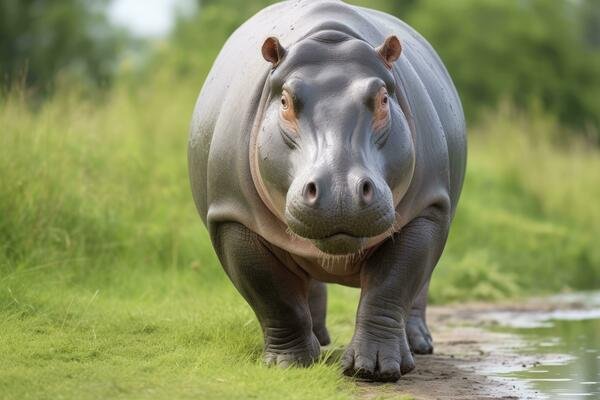
The pig-like size of a hippo might lead you to think of them as clumsy, but trust me, they’re much more complex. Picture them lounging in muddy waters during the hot African afternoons, soaking themselves while keeping cool—yet, they’re also capable of sprinting surprisingly fast on land. You might be wondering how they pull off such contrasting lifestyles. Let me explain how their unique features and behaviors make them perfectly suited for life in both aquatic and terrestrial environments.
Physical Adaptations for Survival
One of the most striking features of hippos is their hefty bodies, which can weigh up to 3,200 kilograms (about 7,000 pounds). While many creatures would find such bulk a hindrance, hippos have evolved some impressive physical adaptations that help them survive. For starters, their bodies are designed to float, thanks to their large, buoyant frames and a layer of fat that acts like a natural flotation device. This allows them to rest in water while keeping most of their bodies submerged, which is a clever way to escape the harsh sun.
Hippos have short legs but can run surprisingly fast on land—up to 30 km/h (about 19 mph). This combination of strength and speed on land gives them an advantage against predators. They can quickly move to and from their water habitats, where they feel most secure. Foot structure is also worth noting: their broad, webbed feet provide stability and support for walking in muddy terrains. Hippos are essentially built like tanks and glide through water with ease, showcasing just how well-suited they are for their habitats.
Water Behavior and Temperature Regulation
Water is life for a hippo, and they spend most of their days submerged to keep cool. Their skin is incredibly sensitive and can easily burn, which is why they’re often found relaxing in muddy waters. The mud acts as a natural sunscreen, protecting them from harmful UV rays. Honestly, you could say they have their own little spa day going on!
When they’re not lounging, hippos can hold their breath underwater for up to five minutes. This amazing ability allows them to escape from danger or simply glide beneath the surface while they move about. They’ll often resurface to breathe while keeping most of their bodies submerged to stay cool. By doing this, they also protect themselves from predators lurking nearby. With their incredible adaptation to water and effective methods for temperature control, hippos manage to thrive even in the hottest climates.
Nutritional Strategies in Harsh Environments
In the wild, finding food can be a challenge, especially in places where resources are limited. Hippos are herbivores, meaning they primarily eat grass, and they’re known to graze during the night when it’s cooler. This nocturnal behavior helps them avoid the heat of the day while ensuring they get their fill of nutrients. A hippo can consume around 40 kg (about 88 pounds) of grass in a single night!
Here’s the thing: hippos have specialized digestive systems that allow them to derive nutrition from grass, which is relatively low in calories. As a result, they need to eat quite a bit to meet their energy requirements. They also have bacteria in their stomachs that help break down tough plant material—this symbiotic relationship ensures they get the nutrients necessary to sustain their massive bodies. By being opportunistic feeders and utilizing the resources available around them, hippos find ways to endure even when food is scarce.
Social Behavior and Group Dynamics
Hippos may seem solitary at times, but they are incredibly social animals. They often live in groups called pods, which can consist of anywhere from a few individuals to over 30. This social structure provides numerous benefits, especially when it comes to survival. Being part of a group offers safety in numbers; hippos can look out for each other and deter potential predators.
Moreover, their social behavior includes vocalizations, like grunts and honks, that help them communicate over long distances. This social interaction is crucial for maintaining group cohesion and ensuring that all members are aware of their surroundings. Hippos are surprisingly protective of one another, especially mothers with calves, showcasing how strong social bonds contribute to survival strategies.
Adapting to Climate Change and Human Impact
Like many species, hippos face significant threats from climate change and human activities. Droughts can reduce water supply, while habitat destruction can threaten their livelihoods. However, hippos have shown a remarkable ability to adapt, often moving to new areas in search of water and food. This adaptability is vital for their survival.
Human activity poses a unique challenge as well. As rivers are dammed or redirected, hippos’ access to their natural habitats can be compromised. Conservation efforts are crucial in protecting their environments, ensuring these majestic creatures continue to thrive. By fostering awareness and supporting policies that protect their habitats, we can help hippos maintain their place in the ecosystem.
Hippopotamuses are truly remarkable creatures that demonstrate how evolution equips animals with the tools they need to thrive in challenging environments. From their impressive physical adaptations to their clever social strategies, hippos embody resilience in the face of adversity. Understanding how they survive gives us greater appreciation for these fascinating animals and highlights the importance of their conservation.
Next time you think about hippos basking in the sun or swimming through rivers, remember the complexities behind their survival strategies. They’re more than just cute faces; they’re a testament to nature’s ingenuity and adaptability. So, let’s keep working to ensure they have a future in the wild, allowing us to continue to marvel at their presence for generations to come.
